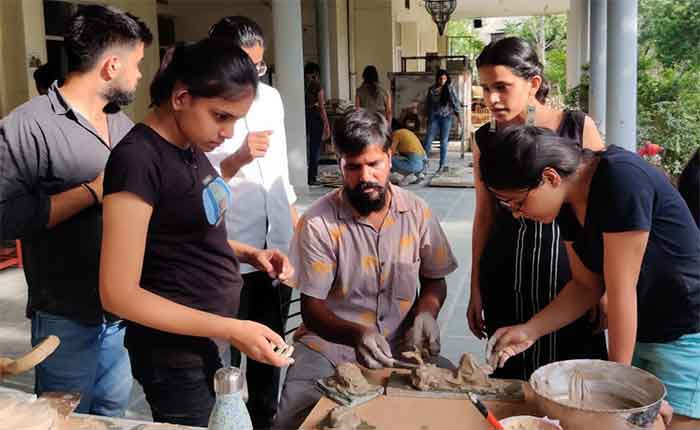The Covid pandemic has made life difficult for 67-year-old Shyam Soni, a sculptor by profession and a resident of Jaipur’s Shastri Nagar. With hardly any work coming in, Soni is struggling hard to make a living for the last 18 months.
His son 44-year-old Rahul Soni who was also into sculpting has already left the profession and joined his friend who runs a provision store.
“We have seen ups and downs in our profession. But this time has been the longest lull. We hardly have any work to do. There are no orders, no takers. Who should I make sculptures for? The workshop has stopped giving new orders to me”, Shyam Soni, said.
Before March 2020 Shyam used to work at a workshop in the walled city part of Jaipur. And occasionally he and his son would also take orders home. But now he hardly visits the workshop.
“I still want to continue my work. I am getting 15 percent of the work only. My son has already made a move and left sculpting, which was our traditional art”, Shyam added.
 The Sonis are not the only ones who have been affected by the Covid-19. The livelihood of around 25,000 artisans working in the sculpting industry in Jaipur has been badly hit. While some have already switched their fields, others are yet to find a solution and are hopeful that things may improve.
The Sonis are not the only ones who have been affected by the Covid-19. The livelihood of around 25,000 artisans working in the sculpting industry in Jaipur has been badly hit. While some have already switched their fields, others are yet to find a solution and are hopeful that things may improve.
Jaipur’s famous Khazane walon ka rasta which houses at least 2000 sculpting workshops is now shrouded in silence. One can see heaps of unsold idols, flower vases, benches, artefacts piled up in the shops. The workshops, which were once abuzz with workers, artists and buyers have become godowns to dump unsold stuff. And each week, the number of items keeps on increasing.
According to the manufacturers, there has been an 80 percent dip in the business and the factors responsible are lack of international tourism, no export and no new construction of temples.
“In the last one and half years, the industry has seen the worst. There has been a hike in the cost of raw materials and production and there has been hardly any demand for our products. As a result, the work has decreased. Earlier, if a sculptor used to make 4 items a month, now we have told them to reduce it to one but make it more beautifully”, Satya Prakash Natha, who runs a fourth-generation shop Natha Moorti Museum in Jaipur told Covid Response Watch.
Covid has hit the livelihood of lakhs of people associated with the industry. Before Covid, a master craftsman used to earn around for Rs. 90,000 in a month. The other assistants also earned around Rs. 30,000-40,000 a month. The overall turnover of this industry was tentatively around Rs. 5000 crores per year. While some have managed to retain their skilled and unskilled labourers in most of the cases, the workshops are running on 50 percent of the manpower.
“How will we sustain? Paying hefty salaries or giving them work has become impossible during the pandemic. In this case, some have left the work or taken a long pause”, Vijay Malpani of Rajasthan Laghu Moorti Udhyog, who runs a manufacturing unit at Shivaji Nagar said.
As per Malpani another factor that has again hit the trade is the delay in the foundation and construction of the new temples. “In the Covid period, there has been no ‘Pratishtha’ ceremony in the temples. In the ceremony, a new idol is placed and it is done in presence of a huge gathering, which has become impossible owing to the Covid protocols”.
The Covid lockdown has severely impacted the marble industry also, halting all operations due to the restrictions imposed. Rajasthan’s Kishangarh, once known as the largest marble market in Asia, appeared like a ghost town during the last two Covid waves. Roads were deserted with most of the marble processing units and factories shut.
Kishangarh’s marble and granite industry is spread across 40 kilometres, with 1,100 units and 25,000 workers. Before Covid-19 hit the country, it did business of up to Rs. 9 crore every day. While factories have reopened now, but still there is no new work.
Jaipur’s artisans also use marble from Makrana for sculptures and as décor for buildings. The Makrana marble is listed as a Global Heritage Stone Resource by the International Union of Geological Sciences and has been used for iconic monuments like the Taj Mahal in Agra, Victoria Memorial in Kolkata and Rashtrapati Bhawan in Delhi. Earlier people from across India and foreigners used to specially visit Jaipur to buy fine ‘Sangemarmar‘ or marble which is made in Makrana but due to consecutive lockdowns, the demand has fallen. The import of marble from Vietnam, another source of the raw material, has also come down drastically.
The pandemic has also taken a toll on freelance sculptor artists and the students.
“The pandemic has tested our patience. I used to get orders for clay, bronze, and sculptors made from the scrap, but the orders have been reduced to 30 per cent. People who could earlier afford costly bronze artefacts now prefer not to buy it as the income has reduced everywhere”, Hansraj Kumawat, a noted artist said.

Interestingly while Hansraj is getting some time off from his sculpting work, he now finds time to teach students at his workshop.
“With colleges shut, those who are studying sculpture making are in dire need of teachers. I hold workshops at my unit and do hands-on training in sculpture-making”, he added.
‘As an artist, the focus has now become to sustain ourselves. Earlier I used to manage to make sculptures for my own creative expression but that has ended now. I can’t afford to do it any more with limited means of income”, he shared.
Jaipur’s famous blue pottery industry has a similar tale to share. The city owes this art form to Sawai Jai Singh I who founded the city of Jaipur in 1727 and invited craftsmen from all over the country. Later, Maharaja Sawai Ram Singh II (1835-80) set up a school of art in the city. Historians believe that the craft came to India with the Muslims around the 14th century and was developed by the Mughals.
“There are hardly any physical sales. Most of the outlets are now selling blue pottery stuff online. The art is already dying. We just have 200 artists left as a community”, Kusum Natha, of Natha Arts who deal with blue pottery shared.
“It requires a lot of hard work, right from procuring the raw material, followed by moulding, finishing, side coating, painting, colouring, glazing firing. An artist has to work for a month to get the final product ready”, added Kusum who is in the trade for the last 50 years. She appreciates simple and elegant designs where blue and white dominate the eye-catching pieces.
The craft has survived many upheavals. It had almost vanished and was revived by the efforts of Rajmata Gayatri Devi of Jaipur, and Kamala Devi Chattopadhyay, distinguished freedom fighter and social reformer, who worked to bring about a revival of Indian handicrafts, handlooms and theatre following Independence.
The president of Blue Pottery Jan Kalyan Samiti , Gopal Saini added, “Foreign tourists were interested in the craft. Artists have been invited to different countries. Efforts have been made to revive the industry. But the Covid became a setback for us”.
The marble industry was in the news before the Covid pandemic also when marble products went from the earlier 5% tax slab to 28% after implementation of the new Goods and Services Tax in 2017. Marble sculptors engaged in the creation of idols from the much sought after stone in Rajasthan were up in arms over the economic implications of this move.
Tabeenah Anjum is a journalist based in Rajasthan, reporting on politics, gender, human rights, and issues impacting marginalized communities. She tweets @tabeenahanjum












































